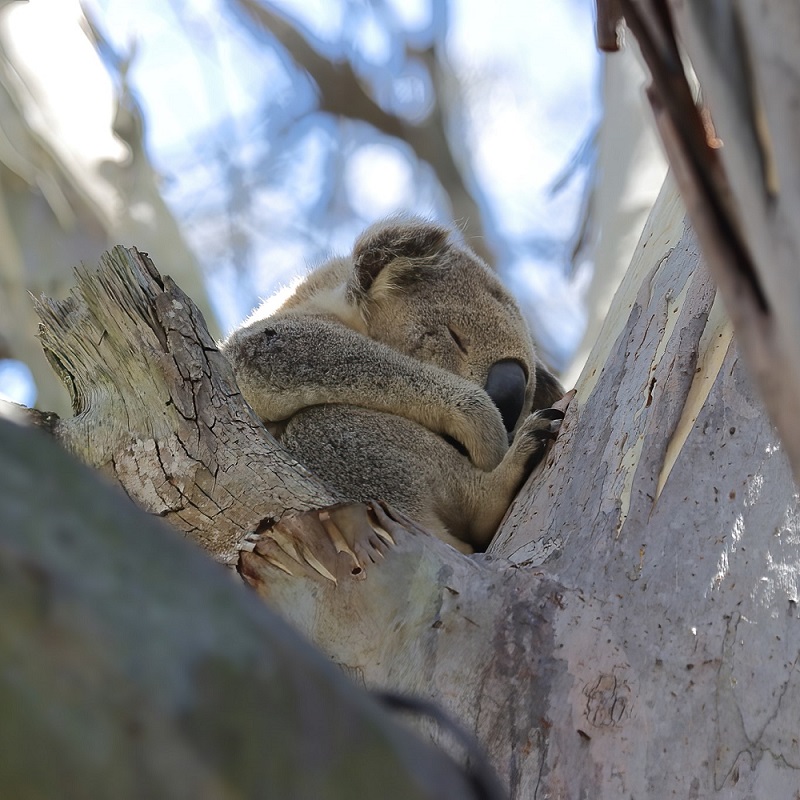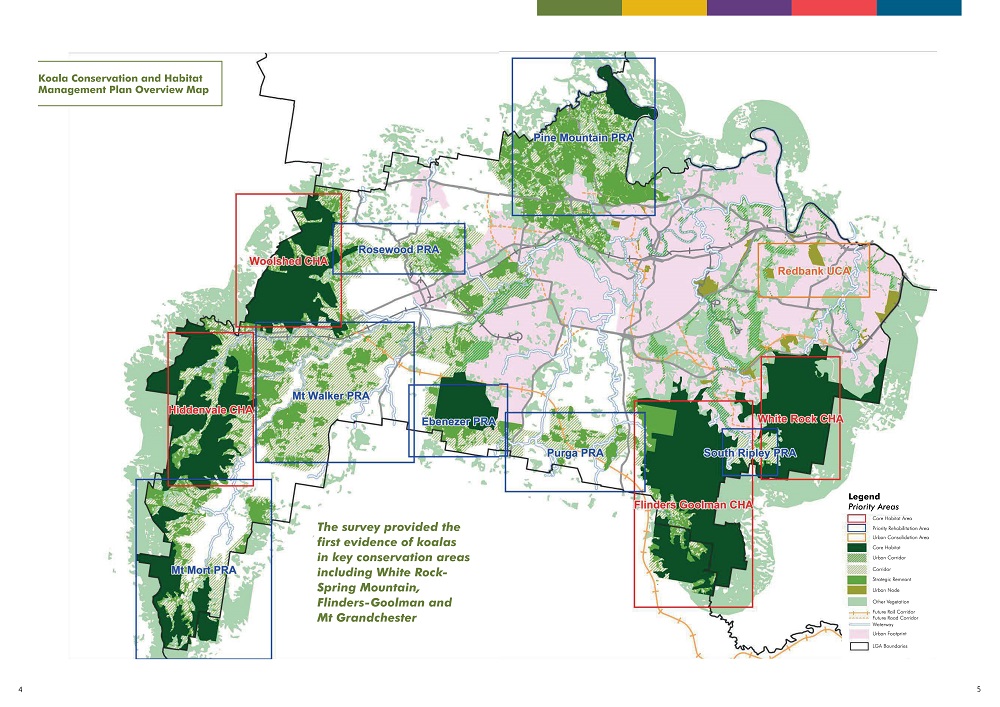Watch out - there are koalas about!
During the warmer months of Spring and Summer, koalas in Queensland are moving around to mate or establish new territory.
Koalas are nocturnal so they are most active between dusk and dawn.
They may be seen crossing roads, navigating backyards, and possible getting caught in dangerous situations.
If you see a sick or injured koala call RSPCA QLD on 1300 ANIMAL (1300 264 625)
The koala is one of Australia's most loved and iconic animals, but their existence is under threat in Queensland.
There are actions you can take in the community to help koala population survival and recovery.
About koalas in Ipswich

The koala is an arboreal (tree-based) marsupial that relies almost entirely on trees from the genus Eucalyptus. Koalas spend the majority of their time in trees. Although they prefer to stay in large patches of bushland, koalas can often be found in riparian corridors (land adjacent to waterways), in strips of roadside vegetation and even in isolated gum trees in grazing paddocks.
Their versatility means that retaining some degree of connectivity across landscapes is crucial to the successful conservation of the species locally. Koalas can move through open space provided they are supported by suitable shelter trees and can move from patch to patch.
Koalas are also still prevalent in many urban areas, surviving in often small and disconnected remnants of bushland. Highly urban suburbs including Collingwood Park and Goodna have recorded koala sightings and present opportunities for long term protection.
Koalas are also abundant in many rural areas, including Thagoona, Ebenezer, Amberley, Mt Forbes and Purga. The koalas in these areas appear to be well adapted to fragmented and patchy landscapes provided there are no major movement barriers.

Image: Overview map from the Koala Conservation and Habitat Management Plan (PDF, 2.8 MB)
Council has more than 8000 hectares of natural area estate, from large Enviroplan Conservation Estates through to urban bushland reserves. This network of bushland areas can provide a safe haven for koalas and other species.
Protecting and managing koala habitat on private land is equally important. Council offers landholders various incentives to achieve this including the Landholder Conservation Partnerships Program.
Council's koala strategy
The Koala Conservation and Habitat Management Plan sets an aim to protect, enhance, manage and increase koala habitat across Ipswich. Koala habitat extends across most of Ipswich, giving koalas a significant local profile and allowing them to be used as a flagship species for broader biodiversity outcomes.
- Koala Conservation and Habitat Management Plan (Summary) (PDF, 2.8 MB)
- Koala Conservation and Habitat Management Plan (Full) (PDF, 4.6 MB)
Main threats to koalas
Koala populations face a range of threats across Ipswich including:
- Loss of habitat: Land clearing for urban and industrial development is a key threatening process in Ipswich. Loss of habitat is a major stress for koalas and during times of stress, koalas are prone to outbreaks of the disease Chlamydia. Retaining linear open space corridors can help to minimise impacts, especially where they link existing parks, reserves and remnant habitat. Private landholders may be eligible for support for habitat restoration through the Landholder Conservation Partnerships Program.
- Road strikes: Koalas often cross busy roads to access food and shelter. Road fatalities are a major cause of koala deaths, with almost 300 koalas recorded as being killed each year by motor vehicles in South-East Queensland. Please keep to the speed limit and take extra care from dusk to dawn, particularly near bushland areas.
- Dog attacks: These are mostly reported in urban areas, often by domestic dogs in suburban backyards. Around 75 per cent of koalas will die from their injuries. It is important to have a koala-friendly backyard and keep dogs on leash when out walking. Train your dog in wildlife avoidance through the Leave It program.
Making a koala friendly backyard
There are a few simple actions that can ensure your backyard is a safe place for koalas to visit.
Retain and plant koala food trees
Koalas have a specialised diet and mainly feed on eucalyptus leaves. You can make your backyard koala friendly by retaining any food trees and also by planting the following trees.
These can be available through council's Free Plant Program (subject to availability). Residents may also be eligible for additional free plants through the Landholder Conservation Partnerships Program.
- Eucalyptus tereticornis (Qld Blue Gum)
- Corymbia citriodora subsp. variegata (Spotted Gum)
- Eucalyptus crebra (Narrow Leaf Ironbark)
- Eucalyptus grandis (Flooded Gum)
- Eucalyptus microcorys (Tallowwood)
- Eucalyptus moluccana (Gummed Topped Box)
- Eucalyptus propinqua (Grey Gum)
- Eucalyptus seeana (Narrow Leaf Red Gum)
- Lophostemon confertus (Qld Brush Box)
Koalas can move tree to tree by climbing across branches or jumping. However they are less agile than their possum cousins and are more likely to climb down to the ground to walk to a new tree. This is why having your dog restrained and having a koala safe backyard is so important!
Watch from a distance
Koalas are easily disturbed and can become stressed. It is better to watch any koalas in your backyard from a distance such as your veranda. Keep a pair of binoculars handy so that you can use them to see the koala "up close". Remember that if the koala feels safe it is more likely to visit your area again.
Koala friendly fencing
Koalas living in urban areas often face several obstacles during their nightly movements. In our suburban areas one of the biggest problems is fencing. Without too much effort or cost, we can assist koalas to move freely and provide them with a quick escape.
Some tips for koala friendly fencing include:
- constructing fences around existing trees and vegetation
- planting of vegetation within close proximity (branches touching) to either side of fence to provide a natural ladder
- place a pole/plank against fence at a 45 degree angle between two supporting upright poles - allows a quick escape
- ensure the thickness of panels or planks provides a walkway along the top of the fence
- leave a small gap between panels/planks to allow koalas to grip and climb
- ensure chain wire fences are topped by a plank or horizontal pole to allow koalas to use it as a bridge
- a suitably planted hedge allows animals passageway while also providing an effective barrier
These fences are well suited to koalas but not necessarily to the ground dwellers such as bandicoots and wallabies. If these animals are in your area, a fence that allows easy access for all fauna is one that has a 30cm gap from the ground to the bottom rail, chain or post of the fence.
Koala safe swimming pool
Even though koalas can swim, they cannot get out of pools using steps. Make your pool koala safe by attaching a thick rope to a floating device, for example, an empty plastic drink bottle. Koalas can use this as a way to climb out if they fall in. Alternatively, place an escape board where a koala can easily reach it and climb out of the pool.
Keep koalas safe from your dog
Dogs will naturally defend their territory from intruders, including a koala. One of the reasons people keep dogs is to increase their security, especially at night. However this is the time when koalas are most active. Even by playing with a koala dogs can cause serious injury and even death as a koala has soft fragile skin and minimal defence ability.
There are some simple tips to ensure that your home and family are kept safe at night while allowing koalas to be safe in your yard. Tie your dog away from any trees, ensuring they have plenty of shade, shelter and water. Alternatively, keep them locked inside at night, either inside your house or in an enclosed verandah or even the garage. Your dog will also provide better protection being close to your home as they will still pick up noises and you will easily hear them bark.
Train your dog in wildlife avoidance through the Leave It program.
Reporting koala sightings
- Report sick, injured or orphaned koalas:
- Ipswich Koala Protection Society - Ikps.org.au
- RSPCA Queensland - Rspcaqld.org.au/ or 1300 ANIMAL (1300 264 625)
- Report koala sightings via the QWildlife app
More Information
Want to know more? Read more about protecting koalas in these guides:
- Map Key Conservation Areas (PDF, 814 kb)
- Koalas in Ipswich (PDF, 726.9 KB)
- Koala Planting Guide (PDF, 1.0 MB)
- Koala Fencing Guide (PDF, 2.6 MB)
- Koala and Domestic Dog Guide (PDF, 1.4 MB)
General koala information